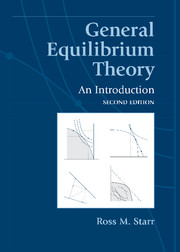Book contents
- Frontmatter
- Contents
- List of illustrations
- Introduction to the second edition
- Preface to the second edition
- Preface to the first edition
- Table of notation
- Table of assumptions
- A General equilibrium theory: Getting acquainted
- B Mathematics
- C An economy with bounded production technology and supply and demand functions
- D An economy with unbounded production technology and supply and demand functions
- E Welfare economics and the scope of markets
- F Bargaining and equilibrium: The core
- G An economy with supply and demand correspondences
- H Standing on the shoulders of giants
- 26 Next steps
- 27 Summary and conclusion
- Bibliography
- Index
27 - Summary and conclusion
from H - Standing on the shoulders of giants
Published online by Cambridge University Press: 05 June 2012
- Frontmatter
- Contents
- List of illustrations
- Introduction to the second edition
- Preface to the second edition
- Preface to the first edition
- Table of notation
- Table of assumptions
- A General equilibrium theory: Getting acquainted
- B Mathematics
- C An economy with bounded production technology and supply and demand functions
- D An economy with unbounded production technology and supply and demand functions
- E Welfare economics and the scope of markets
- F Bargaining and equilibrium: The core
- G An economy with supply and demand correspondences
- H Standing on the shoulders of giants
- 26 Next steps
- 27 Summary and conclusion
- Bibliography
- Index
Summary
We have covered a classic array of topics in this volume: formulation of the general equilibrium model, existence of general equilibrium, efficiency of general equilibrium, the core of a market economy, and futures and contingent commodity markets.
Overview and summary
The ideas treated in this volume have focused on a single unifying idea as a framework for analyzing economic activity: the general equilibrium of a competitive market. General equilibrium – treating all markets and their interactions simultaneously – is thought here to be the appropriate model to decide whether there are well-defined solutions to the economic decision-making mechanism and whether they have efficiency properties making them desirable. This class of questions goes back well over 200 years in scientific economics. The way we answer them here is the Arrow-Debreu version of the Walrasian economic model (Arrow and Debreu [1954], Arrow [1951]).
We have come to several principal conclusions:
(i) The models have well-defined solutions; equilibria exist. Sufficient conditions for this result are scarcity, continuity, and convexity on both the consumer and producer sides. This is true both in settings where demand and supply are characterized as point-valued functions and optimizing behavior is uniquely well defined (Theorems 5.1, 14.1, and 18.1) and where they are characterized as set-valued mappings (Theorem 24.7) recognizing the multiplicity of equally profitable production plans a firm may have or the variety of equally satisfactory affordable consumption plans households may consider.
[…]
- Type
- Chapter
- Information
- General Equilibrium TheoryAn Introduction, pp. 332 - 334Publisher: Cambridge University PressPrint publication year: 2011



